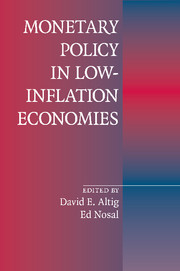Book contents
- Frontmatter
- Contents
- Contributors
- Acknowledgments
- Introduction
- 1 The Welfare Cost of Inflation in the Presence of Inside Money
- Commentary
- 2 An Open-Economy Model of Endogenous Price Flexibility
- Commentary
- 3 Efficient Inflation Targets for Distorted Dynamic Economies
- Commentary
- 4 Inflation and Welfare in Models with Trading Frictions
- Commentary
- 5 Good versus Bad Deflation: Lessons from the Gold Standard Era
- Commentary
- 6 Monetary Policy Orientation in Times of Low Inflation
- Commentary
- 7 Observations on Disinflation in Transition Economies
- Commentary
- 8 Inflation and Financial Market Performance: What Have We Learned in the Last Ten Years?
- Commentary
- Index
5 - Good versus Bad Deflation: Lessons from the Gold Standard Era
Published online by Cambridge University Press: 26 January 2010
- Frontmatter
- Contents
- Contributors
- Acknowledgments
- Introduction
- 1 The Welfare Cost of Inflation in the Presence of Inside Money
- Commentary
- 2 An Open-Economy Model of Endogenous Price Flexibility
- Commentary
- 3 Efficient Inflation Targets for Distorted Dynamic Economies
- Commentary
- 4 Inflation and Welfare in Models with Trading Frictions
- Commentary
- 5 Good versus Bad Deflation: Lessons from the Gold Standard Era
- Commentary
- 6 Monetary Policy Orientation in Times of Low Inflation
- Commentary
- 7 Observations on Disinflation in Transition Economies
- Commentary
- 8 Inflation and Financial Market Performance: What Have We Learned in the Last Ten Years?
- Commentary
- Index
Summary
INTRODUCTION
Concerns expressed by the Federal Open Market Committee at its meeting in May 2003 that the “balance of risks in the U.S. had shifted in favor of deflation”; similar concerns raised by an International Monetary Fund (IMF) report on deflation (2002) over the risk of deflation in Europe, especially Germany and Switzerland; and the experience of declining price levels in China and Japan have sparked new interest in the subject of deflation. In this paper, we examine the issue from a historical perspective. We focus on the experience of deflation in the late nineteenth century, when most of the countries of the world adhered to the classical gold standard. The period 1880–1914 was characterized by two decades of secular deflation followed by two decades of secular inflation.
The price level experience of the pre-1914 period has considerable resonance for recent concerns over the possibility of deflation's reemergence. Four elements of the earlier experience are relevant to today's environment: (1) Deflation was relatively low (1%–3% in most countries); (2) productivity advance was rapid; (3) the real economy was growing; and (4) the price level was anchored by a credible nominal anchor—adherence to gold convertibility.
Deflation has had a bad rap. Possibly as a consequence of the combination of deflation and depression in the 1930s, deflation is associated with (for some, it connotes) depression. In contrast, a basic tenet of monetary theory—the Friedman rule—suggests that deflation (albeit perfectly anticipated) is an outcome of optimal monetary policy.
- Type
- Chapter
- Information
- Monetary Policy in Low-Inflation Economies , pp. 127 - 174Publisher: Cambridge University PressPrint publication year: 2009
- 4
- Cited by



